The Nasuni File Data Platform is a cloud-first storage solution that stores data in a global file system (UniFS) hosted in the cloud (on AWS, Azure, or GCP). One of Nasuni’s claims is around fast edge performance. This article addresses their edge capabilities–and situations where synchronizing across the edge may not be so fast.
As part of Nasuni’s Access Anywhere offering, Nasuni Edge Appliances (deployed as virtual machines or Dell servers) are deployed at remote sites. Each edge appliance communicates with UniFS to provide high-performance file access by caching frequently used files at each endpoint.
Nasuni’s cloud solution is packed with storage features that, depending on your use case, enable you to lower capital costs and collaborate across sites. However, Nasuni also suffers from foundational architecture issues. For example:
- Its hub-and-spoke replication architecture can become a performance bottleneck in some remote access and collaboration scenarios. For example, in cases where users need to synchronize large files or many files with another user in another remote office, the synchronization must flow through the hub before trickling out to the other site (the spoke). It’s also challenging for multiple collaborators to rapidly collaborate on the same file across multiple locations.
- For faster file transfer and synchronization, Nasuni Access Anywhere utilizes a TCP-based streaming technology called Mstream, which breaks up large files into smaller pieces and transfers them in parallel. This is cumbersome and error-prone. It also doesn’t work well in multidirectional scenarios where multiple locations are concurrently synchronizing files.
- Its limited set of WAN optimization features don’t fully address the challenges of transfers over WANs and unreliable networks (i.e., latency, packet loss, bandwidth variability, etc.).
- Its inability to sync in real-time or in multiple sync directions limits its usefulness in fast-paced remote collaboration workflows, high-performance VDI applications, hot-site disaster recovery, and more.
- Its proprietary file system (UniFS) requires an “all-in” commitment to Nasuni. If you ever want to migrate to another storage vendor, there is complexity involved in migrating files and metadata. By contrast, Resilio utilizes open file formats, is cross-platform, and supports any type of storage — from any storage vendor.
In this article, we’ll discuss the features, capabilities, and shortcomings of Nasuni Edge. We’ll also compare it to our alternative peer-to-peer file synchronization and object storage gateway solution, Resilio Active Everywhere.
Unlike Nasuni, Resilio offers a software-only approach, supporting any type of storage (file, block, or object) from any vendor. It’s cross-platform, runs on any type of server or storage, and utilizes open file formats.
At its core, Resilio offers a highly-resilient, multidirectional file replication and synchronization solution. You have the flexibility to deploy Resilio all on premises, in a hybrid cloud, or cloud-native.
Moreover, you can use virtually any device to enable real-time collaboration for hybrid work and other use cases. There’s no requirement to deploy edge appliances, as Resilio is an agent-based solution where software runs on each endpoint. A central management console simplifies managing up to many thousands of endpoints per instance.
Some of our current users switched from Nasuni to Resilio because it provides:
- Fast P2P (peer-to-peer) synchronization: While Nasuni syncs data using a hub-and-spoke, Resilio syncs using a distributed P2P model. Sync can be in real-time or on-demand. This enables Resilio to sync data 3–10x faster than hub and spoke, scale organically, and sync in any direction. Resilio can also perform real-time, scheduled, and manual syncs.
- Resilience: Unlike hub-and-spoke solutions, P2P replication environments have no single point of failure. If any endpoint goes down, the necessary files or services can be retrieved from any other endpoint. Resilio also dynamically reroutes around outages, automatically retries transfers until they’re complete, and resumes interrupted transfers at the point of interruption.
- Reliable transfer over any network: Resilio uses a proprietary WAN acceleration protocol that intelligently analyzes and automatically adapts to the conditions of any network, ensuring the fastest possible transfer speeds and a predictable rate of transfer.
- Features that enhance efficiency and productivity: Resilio’s object storage gateway includes features that reduce data egress costs (such as selective sync and caching) and enhance productivity (such as policy-based automation). Plus, Resilio’s P2P architecture enables it to deliver global file access directly to each endpoint in your environment, improving access to files in situations where data locality matters.
- Flexible integration into any environment and workflow: Resilio is a vendor and workflow-agnostic solution that you can deploy onto just about any IT environment and integrates seamlessly with your workflow and the solutions you already use.
- Centralized management and granular control over your environment: Resilio enables you to manage your entire environment from a centralized Management Console that can be accessed from any web browser. It gives you granular control over every aspect of data sync and access and allows you to automate these processes for easier management.
- Bulletproof security features: While both solutions contain some similar security features, Resilio provides extra security through file validation, proxy server capabilities, and more.
- Cross-platform: Resilio runs on Windows, Linux, macOS, Android, FreeBSD, and a variety of NAS partner systems. There’s no proprietary file system. Resilio integrates with each host operating system to capture file changes and metadata for each OS.
Organizations use Resilio Platform to provide fast, reliable file sync and access for many use cases, such as VDI profile sync, disaster recovery, multi-site collaboration and remote work, edge synchronization, server synchronization, and more. To see how Resilio can enhance your hybrid cloud deployment, schedule a demo with our team.
File Replication Architecture and Capabilities
When choosing a solution for hybrid cloud and edge deployments, replication speed and reliability are among the first and most critical things to consider. In other words, you need to understand how the solution replicates data, how quickly it can sync your environment (amount of data and number of endpoints), and how it handles transfers over WANs and unreliable networks.
A slow and unreliable solution can lead to:
- Sync delays that interrupt workflows and force employees to wait for files to update.
- Slow time-to-desktop for VDI files (which interrupts your VDI applications and workflows).
- File conflicts that occur when updates don’t sync across every endpoint fast enough.
- Poor disaster recovery metrics (i.e., slow RPOs and long RTOs).
Nasuni’s Hub-and-Spoke Replication Architecture and Sync Capabilities
As stated earlier, Nasuni is a global file system that’s hosted in the cloud. Like all global file systems, it uses a hub-and-spoke replication architecture that limits its replication and sync capabilities.
A hub-and-spoke architecture consists of a hub server and several remote servers. The remote servers can’t share files directly with each other. All file transfers must first be sent to the hub server, which then replicates the data to each remote server one by one.
A hub-and-spoke architecture results in replication that is:
- Slow: Remote servers must first send their data to the hub server, creating an unnecessary extra step for synchronization. And the hub server can only sync data with one remote server at a time, so syncing large amounts of data across many endpoints will take a long time.
- Unreliable: Hub-and-spoke architectures create single points of failure. If replication is slow or fails on any remote server, it can delay synchronization for the rest of your environment. And if the hub server goes down, replication fails entirely.
While these two negative characteristics of hub-and-spoke architectures are bad enough, Nasuni suffers from another delay due to how it syncs updates.
Nasuni can’t perform real-time synchronization. Files are synced across your environment on a set schedule, based on time intervals that you define (e.g., every 30 minutes). But file updates at each endpoint only become available after every endpoint syncs to the cloud.
For example, assume your environment contains five endpoints and you schedule each endpoint to sync every five minutes (the minimum amount of time recommended by Nasuni’s best practices). This means you will only be able to see newly updated files at any endpoint every 25 minutes (i.e., 5 endpoints x 5 minutes per endpoint).
Such a delay alone may be unworkable for some use cases that require fast-paced, real-time collaboration among distributed teams. In addition, as you scale and add more endpoints to your environment, the time it takes to see/sync updates will increase significantly.
Resilio Active Everywhere P2P Replication Architecture and Sync Capabilities
Resilio Platform is one of the only file synchronization solutions that can sync in real time and uses a peer-to-peer replication architecture to sync files. In a P2P model, every endpoint in your environment can share files directly with every other endpoint. And all endpoints can share files simultaneously.
This allows Resilio to satisfy the requirements of any hybrid cloud use case and:
- Achieve blazing-fast sync speeds
- Sync in any direction
- Scale organically
- Eliminate single points of failure
Blazing Fast Sync Speeds
Resilio uses a process known as file chunking to break files down into small chunks that can transfer independently of each other. The combination of file chunking and P2P sync is key to Resilio’s ability to achieve blazing-fast sync speeds.
For example, imagine you wanted to sync a file across five endpoints. Resilio could split that file into five chunks and each endpoint could work together to share them across your environment. Endpoint 1 can share the first chunk with Endpoint 2. Endpoint 2 could immediately share that chunk with any other endpoint, even before it receives the remaining four file chunks. Soon every endpoint will be sharing file chunks, enabling you to sync your environment 3–10x faster than hub and spoke solutions like Nasuni (as demonstrated in the image below).

And unlike Nasuni, updates are immediately available at each endpoint — there’s no need to wait for your entire environment to sync.
Sync in Any Direction
Resilio’s P2P architecture enables it to sync files in any direction, such as:
- One-way: Backup files to a backup site or migrate to the cloud.
- Two-way: Keep two endpoints synchronized for multi-site collaboration.
- One-to-many: Distribute software updates from one server to many endpoints at once. Or distribute mission-critical files out to a fleet of vehicles in the field.
- Many-to-one: Collect data from multiple endpoints onto one server, or from a fleet of vehicles in the field back to headquarters.
- N-way: Keep multiple (hundreds or even thousands) of endpoints synchronized simultaneously.
N-way sync is a particularly powerful capability of Resilio that gives it an advantage over other file synchronization solutions like Nasuni, as it enhances Resilio’s performance in a variety of use cases.
In hot-site disaster recovery scenarios, Resilio’s P2P architecture and N-way sync capabilities provide each endpoint in your environment with the power of a data center or backup site. All files and file updates are synchronized across every endpoint. You can configure failover to or from any endpoint, enabling Active-Active High Availability. And in the event of a disaster, every endpoint can work together to bring your application back online — which allows Resilio to achieve sub-five-second RPOs (as mentioned earlier) and RTOs (Recovery Time Objectives) within minutes of an outage.
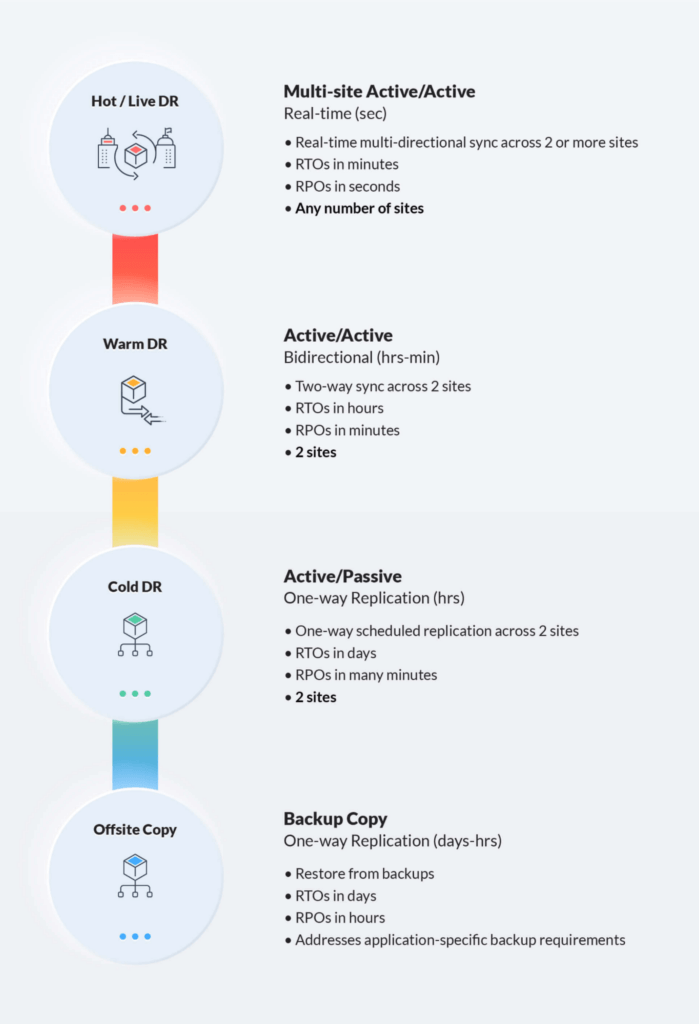
N-way sync enables fast collaboration among any number of remote endpoints in remote work scenarios. If an employee at any location makes a change to a file, that file change is immediately synchronized to every other endpoint/office — so everyone always has the most up-to-date version of files.
N-way sync allows Resilio clients like Mixhits Radio (a music streaming service) to keep music metadata synchronized across all of their servers. As soon as a music program is updated in any location, those “file changes are detected and propagated across servers within two seconds.”
And N-way sync enables organizations to keep their VDI profiles in sync, allowing them to achieve a faster time-to-desktop, provide a better user experience, and meet SLAs.
Scale Organically
As discussed earlier, hub-and-spoke environments scale poorly — i.e., synchronization takes longer and is less reliable as you add more endpoints to your environment.
But Resilio was designed to support large-scale, enterprise needs. It can sync:
- Files of any size: Resilio can sync GB and TB-sized files, such as large images, video, and text files.
- Any number of files: Resilio’s engineers successfully synchronized 450+ million files in a single job.
- Any type of file: Organizations in various industries (such as gaming, construction, media, engineering, healthcare, and more) use Resilio to sync different types of files — such as game-builds, CAD designs, telemetry data, IoT data, 3D models, and more.
- Any number of endpoints: Since every endpoint can share files with every other endpoint simultaneously, adding new endpoints only increases replication speed and resources (i.e., CPU, bandwidth, etc.). Resilio can sync 200 endpoints in roughly the same time it takes most hub-and-spoke solutions to sync just two.
Resilio’s P2P architecture also enables it to perform a process known as horizontal scale-out replication. This allows you to cluster endpoints together to pool their resources and increase replication speeds linearly. Using scale-out replication, our engineers were able to reach speeds of 100+ Gbps per cluster (though you can combine more endpoints to reach even greater speeds, and there’s no limit to how fast you can go).

Eliminate Single Points of Failure
While hub-and-spoke environments suffer from multiple single points of failure, P2P environments eliminate them.
Since every endpoint can share files directly with every other endpoint, there are no single points of failure. If any endpoint goes down, the necessary files or services can be retrieved from any other endpoint in your environment.
Resilio also includes other features that enhance reliability even further, such as:
- Dynamic rerouting: If any endpoint or network goes down, Resilio can dynamically reroute around it and find the optimal path to deliver your data to its destination.
- Automatic retries: Resilio automatically retries all transfers until they’re complete.
- Checksum restarts: If a transfer is interrupted, Resilio can perform a checksum restart to resume the transfer at the point of interruption.
Real-Time Synchronization
Resilio can perform real-time, scheduled, or manual syncs.
It uses notification events from the host OS and optimized checksum calculations (i.e., identification markers assigned to each file that change when a change is made to the file) to immediately detect and replicate file changes. And it replicates only the changed portions of files for faster transfers.
This capability can enhance many hybrid cloud use cases. For example, real-time sync enables Resilio to achieve sub-five second RPOs (Recovery Point Objectives) for disaster recovery (as data is immediately synchronized and available for backup) and fast time-to-desktop for VDI applications (as VDI profile data is immediately synchronized across your environment).
A global construction company used Resilio to enhance performance for their VDI deployment, including:
- Continuous Active-Active High Availability across all sites.
- 2-5x increase in login times (15-30 seconds from user click to desktop).
- Provide fast, localized access to their applications and 3D design tools for 90+ users at the edge.
Nasuni Edge WAN Optimization
Edge deployments often involve transferring files over long-distance WANs (wide area networks) as well as unreliable network connections (such as edge networks and consumer-grade networks used by work-from-home employees). In order to be useful, a solution must include features that optimize transfers over these networks. Otherwise, it can lead to slow and unreliable file transfers that interrupt workflows and cause issues for IT teams.
Nasuni Edge suffers from two issues that inhibit its ability to transfer over WANs and edge networks.
The first issue is that Nasuni uses FTP (File Transfer Protocol) and SFTP (Secure File Transfer Protocol) transfer protocols — which are both TCP-based (Transmission Control Protocol) protocols.
TCP protocols can reliably transfer over LANs (Local Area Networks). But their performance is limited over WANs and edge networks because:
- They require an ordered transmission of data packets. In other words, the receiving device must acknowledge the receipt of each packet before the sending device can send another packet. This increases traffic over the network and delays packet transfers.
- They respond poorly to packet loss. Packet loss can occur often over WANs and edge networks. TCP protocols assume that excess packet loss is a network congestion issue, and reduce transfer speeds in response. Since packet loss over WANs and edge networks isn’t necessarily due to congestion, this is a poor response that unnecessarily reduces transfer speeds.
The second issue is that Nasuni’s WAN optimization features are insufficient to address the challenges of WANs and edge networks.
Nasuni optimizes transfers using multi-threaded replication, deduplication, and data compression. But these features don’t dynamically adjust to changing network conditions (such as packet loss and network congestion), resulting in inefficient utilization of network bandwidth.
Nasuni’s deduplication is also performed at the chunk or object level (usually at a default of 4MB chunks), resulting in less efficient WAN bandwidth utilization, local caching, and cloud data storage.
Resilio Platform WAN Optimization
While Resilio uses TCP for local transfers, it uses a proprietary WAN acceleration protocol for transfers over WAN and edge networks known as Zero Gravity Transport™ (ZGT).
ZGT is a UDP-based (User Datagram Protocol) transfer protocol. UDP file transfer protocols don’t require an ordered transfer of data packets or react to packet loss like TCP protocols. While this can make UDP protocols less reliable than TCP (as there’s no way to ensure the entire file gets delivered), Resilio’s ZGT protocol accounts for these issues in order to maximize both speed and reliability.
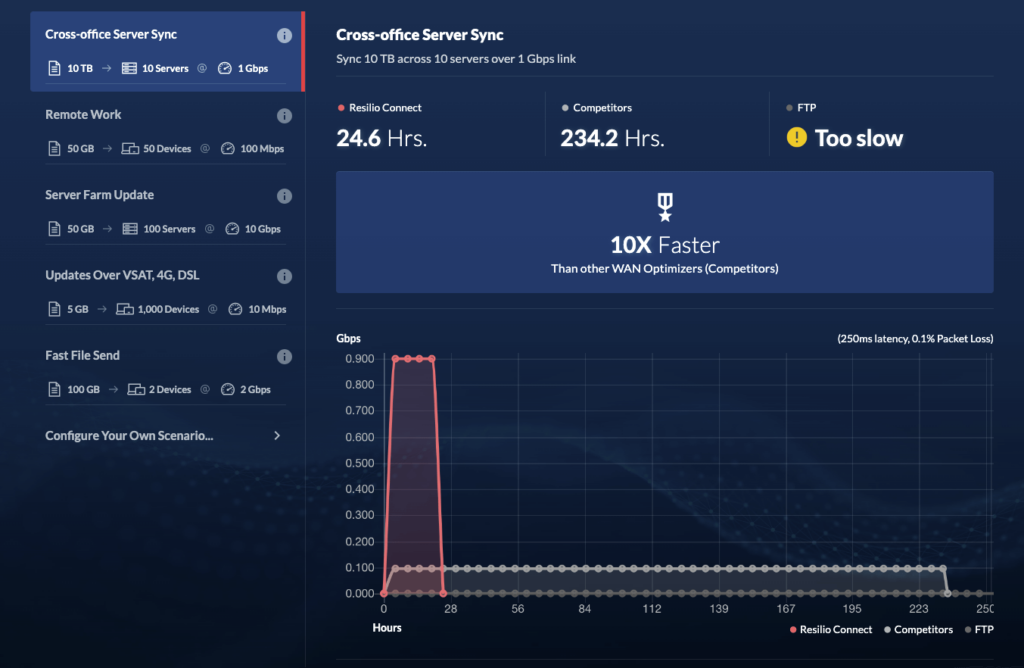
ZGT accomplishes this by utilizing:
- A congestion control algorithm: ZGT uses a congestion control algorithm that periodically probes the Round Trip Time of a network in order to identify and maintain the optimal rate of packet transfer.
- Interval acknowledgments: Rather than requiring the receiving device to acknowledge each packet, ZGT sends acknowledgements for groups of packets — decreasing network traffic while allowing for a continuous data stream.
- Delayed retransmission: ZGT retransmits lost packets once per RTT in order to decrease unnecessary retransmissions.
- Cryptographic data integrity validation: Resilio transmits the metadata and data hash of each file before transmitting the files themselves. The receiving device can check each file against the hash/metadata to ensure the file is intact and uncorrupted. If a file doesn’t match the hash/metadata, it is immediately discarded and scheduled for retransmission.
This allows ZGT to intelligently analyze the underlying conditions of a network (such as packet loss, network congestion, and throughput over time) and dynamically adjust to these conditions to ensure the fastest transfer speeds possible and uniform distribution of packets over time.
ZGT enables Resilio to transfer files over WANs 100x faster than TCP protocols. In fact, our engineers successfully transferred a 1 TB dataset across Azure regions in 90 seconds.
Object Storage Gateway
Both Nasuni and Resilio Platform provide access to files through an object storage gateway. While there aren’t any inherent problems with Nasuni’s object storage gateway, Resilio includes additional features that enhance productivity and reduce cloud data transfer costs.
Nasuni Edge Object Storage Gateway
Nasuni’s object storage gateway feature works through Nasuni Edges, which (as stated earlier) are efficient virtual machines that provide up to a 98% cache hit rate. Nasuni Edges are deployed on your NAS (Network Attached Storage) devices and file servers, enabling them to connect to your cloud object storage (which serves as a single source of truth).
Nasuni Edges provide:
- File access: Nasuni stores data in a cloud-native global file system. It provides file access through SMB, CIFS, NFS, FTP/SFTP, and HTTPS protocols.
- Caching: Nasuni can cache frequently used files on local devices. It also uses intelligent data and metadata analysis to predict and cache the files that you’re most likely to use.
- Global file locking: Nasuni uses file locking, which locks files so only one employee can edit them at a time, to enable multi-site collaboration.
Resilio Platform Object Storage Gateway
Resilio provides a turnkey object storage gateway (through Resilio agents installed on each endpoint) that provides low-latency access to data stored in any file, block, or object storage. It allows you to transform your NAS/DAS/SAN devices, file servers, desktops, and mobile devices into flexible storage gateways.
Resilio’s gateway supports one of two models:
- A central gateway in your office or remote sites
- Direct access from any end user’s workstation or desktop
The file gateway runs as a VM or physical server. It enables end-users and applications to access files through SMB or NFS protocols. And it supports just about any:
- Operating system, such as macOS, Windows, Linux, Unix, and more.
- Cloud storage platform, such as Google Cloud Platform, Azure Blobs, AWS S3, MinIO Ceph, Cloudian, Weka IO, VAST Data, Cloudian, and more.
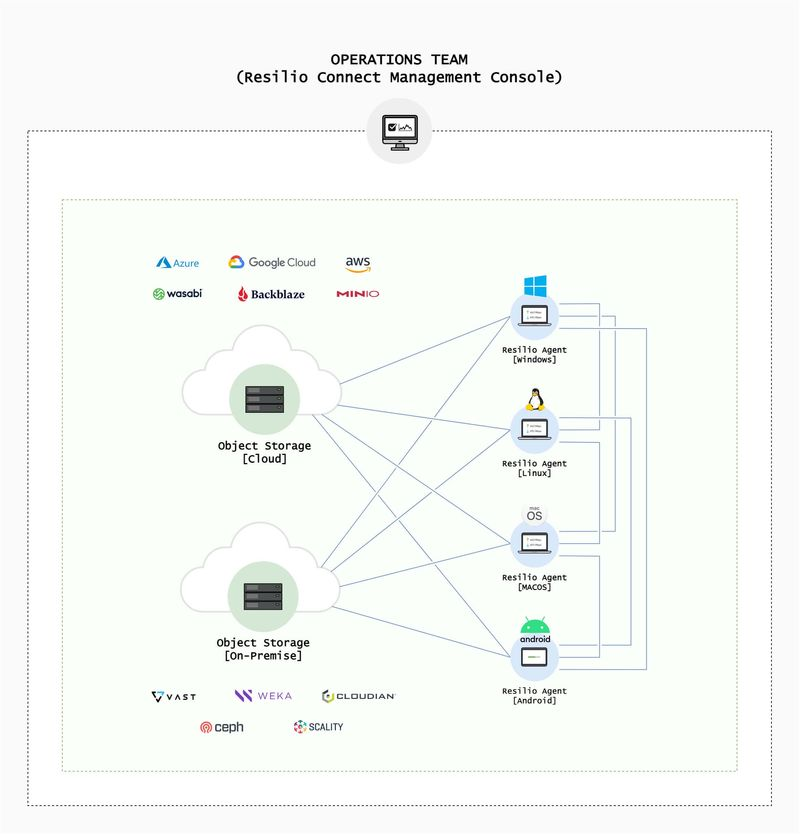
But Resilio also enhances productivity by enabling you to seamlessly integrate object storage into your file-based workflows while also minimizing cloud storage and transfer costs through features such as:
Selective Caching
You can cache files directly on any device with a local file system. While Resilio can cache frequently accessed files, it also allows you to cache any files you choose through a feature known as selective caching. This allows you to provide fast access to important files while also reducing data egress costs.
Selective Synchronization
Resilio enables you to control which specific files and folders are synced to which specific endpoints. You can ensure that files are only synced to where they need to be, reducing data transfer costs. And, in remote work scenarios where privileged files should only be synced to privileged employees, this feature gives you granular control over how and where files are synced.
Full or Partial Downloading
When downloading files, end-users can perform full downloads or partial downloads, so they get access to just the portions of files/folders they need. Partial downloads can reduce data egress costs by minimizing the amount of data that’s downloaded while providing faster access to data.
Policy-Based Automation
You can create policies that automate how files are automatically synchronized, downloaded, cached, and purged. This allows you to free up employees to focus on their tasks.
Proxy Server
Resilio provides Proxy Server capabilities that allow you to:
- Control who is allowed to access certain files on certain machines.
- Control which scripts are able to run on certain machines.
- Support complex firewall configurations.
This enables you to securely support remote work and 3rd-party collaboration scenarios.
Overcoming Latency
By providing blazing fast transfers over any network and across any distance, Resilio’s P2P architecture and WAN acceleration protocol enable you to overcome latency. And Resilio delivers global file access directly to each endpoint.
Unified Access to Data
Resilio provides a single, unified file interface that operates much like popular file management tools (such as MacFinder, Microsoft OneDrive, and Windows File Explorer). End-users get a similar view of files through a familiar browsing experience.
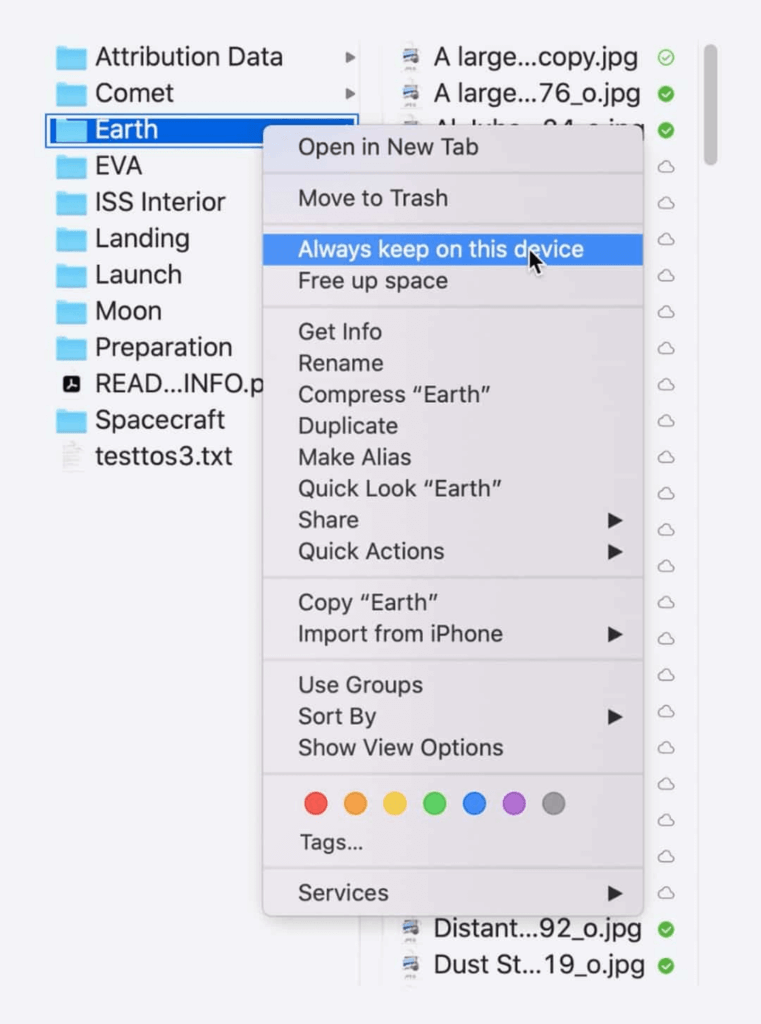
Management and Automation
A good hybrid-cloud sync and access solution should integrate easily into your current IT infrastructure and operational workflow, with little investment required. And it should make managing your data environment easier by providing full control from a centralized interface.
With a few caveats, Nasuni and Resilio both provide flexible hybrid cloud solutions that are easy to manage and automate.
Nasuni Edge Management and Automation
Nasuni Edges are virtual machines that extend the Nasuni File Data Platform to edge deployments. Both are managed by the Nasuni Management Console — a web-based interface for managing, provisioning, and reporting on Nasuni sync and file access processes (i.e., edges, recoveries, snapshots, protocols, file shares, volumes, etc.)
The Nasuni File Data Platform is a fairly flexible solution that easily integrates into most hybrid cloud workflows. It supports:
- NAS devices and file servers.
- Popular operating systems, such as Windows, Linux, and macOS.
- In addition to Nasuni Cloud File Storage, Nasuni supports public cloud storage systems— such as AWS S3, Google Cloud Platform, and Azure Blobs — as well as private cloud providers — such as Dell EMC ECS, NetApp StorageGRID, Pure Storage FlashBlade, and more.
- Integrations with workflow management tools (such as Siemens Teamcenter PLM, Work, and Azure Power Automate), design apps (such as Adobe Creative Cloud, AutoCAD, Revit, and BIM360), and other popular solutions.
Through Nasuni’s API, you can use scripts and 3rd-party workflow solutions to automate all sync and data management functions.
Resilio Platform Management and Automation
One of the key differentiators between Resilio Platform and other enterprise file sync solutions is that Resilio was designed with open file formats and universal protocols. Not only does this allow you to retain full control over your data (as you’re never locked into any vendors and your data is never stored in any proprietary formats), but it also makes Resilio an incredibly flexible and cost-effective solution that:
- Seamlessly integrates into any IT infrastructure and hybrid cloud or edge workflow.
- Provides easy management and granular control over every aspect of data sync and access.
- Enables you to easily automate processes to reduce management time and the need for human intervention.
Seamless Integration into Any IT Infrastructure and Workflow
Resilio is a vendor-agnostic solution that you can install on your existing IT infrastructure at minimal cost (there’s no need to invest in new hardware or software) and with minimal operational interruption.
This level of flexibility makes Resilio an ideal alternative to competing solutions like Nasuni and Panzura. You can use Resilio with your choice of:
- Storage devices: You can install Resilio agents on file servers, NAS/DAS/SAN devices, file servers, laptops, desktops, mobile devices (Resilio provides iOS and Android apps), IoT devices, and virtual machines (such as VMware, hypervisors, and more).
- Cloud storage platforms: Resilio supports just about any S3-compatible cloud object storage, such as Google Cloud Platform, Amazon Web Services S3, Microsoft Azure Blobs, MinIO, Wasabi, Cloudian, Backblaze, NetApp, Weka IO, and more.
- Operating system: Resilio supports just about any operating system, such as Windows, macOS, Linux, Unix, FreeBSD, Ubuntu, OpenBSD, and more.
- Workflow software: Resilio integrates with popular solutions your team is already using. You can integrate with management tools (LCE, Microsoft SCOM, Splunk, etc.), engineering tools (AutoCAD, Revit, CSI Sap2000, etc.), media tools (DaVinci Resolve, Adobe Premier, Avid Media Composer, etc.), development tools (Jenkins, TeamCity, etc.), and more.
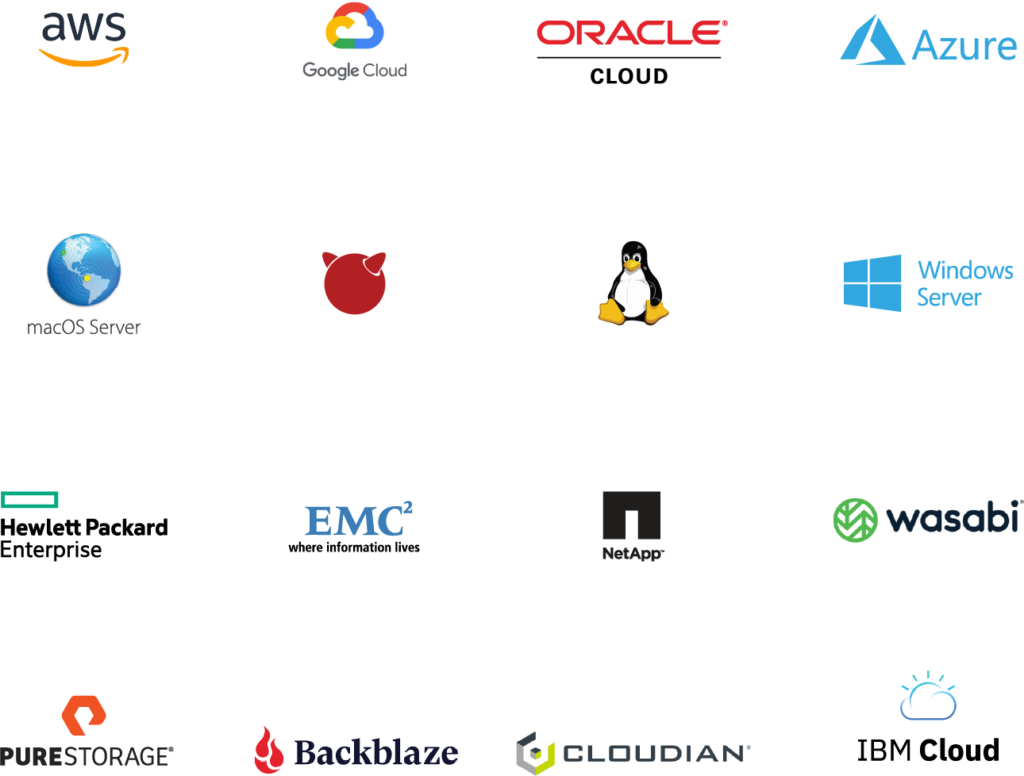
Easy Management and Granular Control
Resilio’s Management Console, which can be accessed from any web browser, provides a centralized location from which you can manage your entire hybrid cloud environment. And it gives you granular control over every aspect of data replication and access, allowing you to:
- Create, manage, and monitor replication jobs.
- Obtain real-time metrics and reports on active jobs.
- Review a history of all executed jobs.
- Adjust replication parameters, such as disk I/O, data hashing, file priorities, syncing metadata, and more.
- Create set-it-and-forget-it automation policies that control how data is synchronized, cached, purged, and downloaded — such as purging files from a cache after a certain number of days.
- Automate troubleshooting processes, such as file conflict resolution.
- Adjust bandwidth at each endpoint manually or create profiles that govern how much bandwidth is allocated to each endpoint at certain times of the day or on certain days of the week.
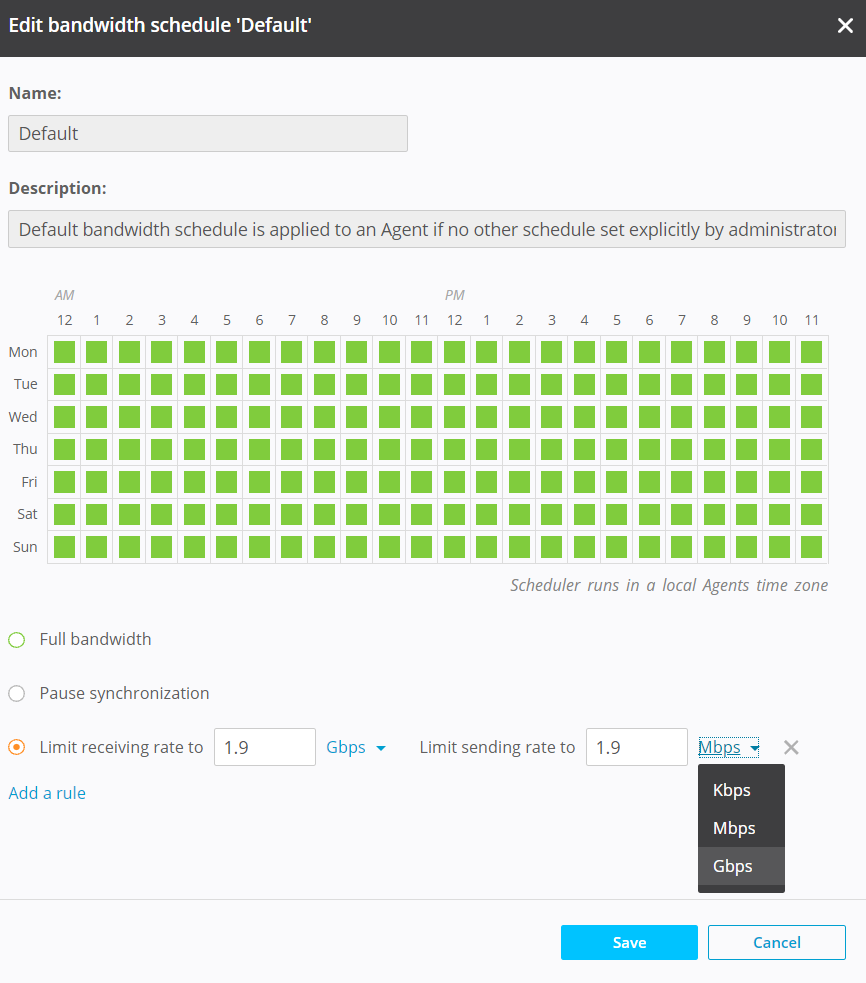
Automating Job Functions
By automating job functions through Resilio’s powerful REST API, you can increase productivity while minimizing management time and the need for human intervention.
You can script any type of functionality a job requires. Resilio scripts provide three types of triggers:
- Before a job starts
- After a job completes
- After all jobs complete
For example, a marine construction company uses Resilio to remotely distribute security updates to each workstation on their fleet of sea vessels over intermittent connections. Prior to Resilio, they used Microsoft SCCM — a solution that required hours of management time from staff and left many vessels years behind in the latest security updates. Resilio enables them to distribute the security updates to each vessel’s central server. Then, the updates are distributed to each workstation onboard over the LAN — all while being remotely monitored by their IT team.
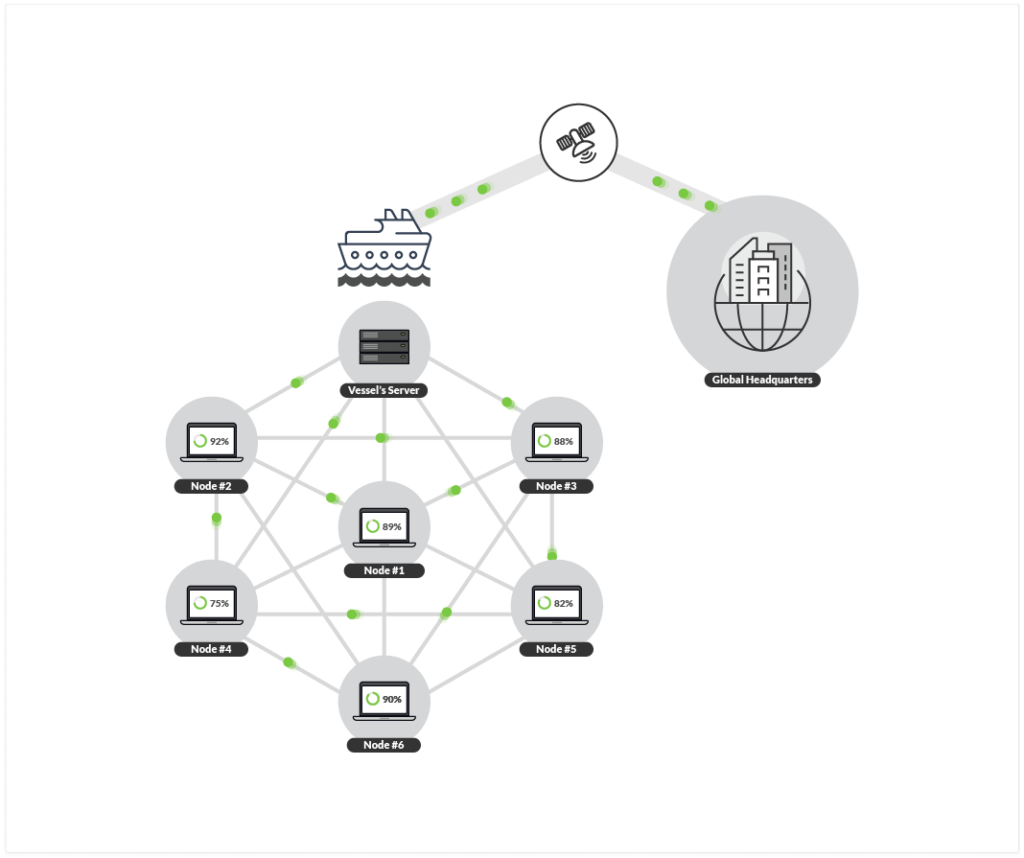
Security Features
Data protection is always important in any use case. However, it becomes essential when transferring data over WANs and vulnerable edge networks.
Both Resilio and Nasuni provide powerful, built-in security features. In this case, you should choose the solution with the security features that work best for your particular use case.
Nasuni Edge Security
Nasuni’s security features include:
- Data encryption: Nasuni protects data at rest and in transit via AES 256-bit encryption.
- Encryption keys: All endpoints are protected via customer-created encryption keys.
- Ransomware protection: Nasuni deploys ransomware detection and mitigation capabilities at the end to defend against cyber attacks.
- Continuous file versioning: Nasuni takes snapshots of file shares at predefined intervals and stores those snapshots as immutable versions in the cloud.
Resilio Platform Security
Resilio protects data via security features that were reviewed by 3rd-party security experts (TPN Blu certified and SOC2 certified), such as:
- End-to-end encryption: Data is protected at rest and in transit via AES 256-bit encryption.
- Cryptographic data integrity validation: As stated earlier, Resilio uses data integrity validation to ensure data arrives at its destination intact and uncorrupted. Damaged files are immediately discarded and scheduled for retransmission.
- Immutable copies: Resilio stores immutable copies of data in the cloud to protect against ransomware.
- Mutual authentication: Every endpoint must provide an authentication key before it can receive files, ensuring your data is only delivered to approved endpoints.
- Permission controls: You can limit access to certain data to privileged employees by controlling who is allowed to access specific files and folders.
- Forward secrecy: Resilio protects each session with one-time session encryption keys.
- Proxy server: As mentioned earlier, Resilio’s Proxy Server capabilities support advanced firewall configurations and enable you to control user and script access on specific machines.

When to Choose Nasuni Edge vs Resilio Active Everywhere
While the differences between Nasuni and Resilio’s object storage gateway, management, and security features are important, the primary difference between the two platforms comes down to their architecture.
In other words, Nasuni is a global file system with a hub-and-spoke architecture and Resilio is a global file replication provider with a distributed peer-to-peer replication architecture.
This key difference has a major impact on how each solution performs — especially at the edge — and which you should choose for your use case.
When to Choose Nasuni Edge
You should choose Nasuni Edge when:
- You want to centralize your storage into a single source of truth, and real-time, localized access at the edge is not a priority.
- Your deployment will not be hindered significantly by a hub-and-spoke replication architecture — i.e., you only need one-way replication between 2-3 endpoints.
- You want global file system-specific features that Nasuni offers (but Resilio does not), such as global file locking and continuous file versioning. NOTE: Resilio works with global namespace technologies and active directories, such as Microsoft DFS and NFS v.4.0 (or any modern version of SMB or NFS).
- Your disaster recovery requirements can be met within the constraints of Nasuni’s snapshot-based replication on a filer or GFS. In other words, your objectives can be met within the limits of one source to one target, your RTO is 15 minutes or more, and you only have two sites.
- You’re using cloud-storage vendors, devices, and operating systems that Nasuni supports.
When to Use Resilio Active Everywhere
You should use Resilio Platform when you need:
- Real-time synchronization: If you need files and file changes immediately synchronized across multiple endpoints (for objectives such as fast time-to-desktop for VDIs or sub-five second RPOs for disaster recovery), then you need Resilio’s real-time replication capabilities.
- Multidirectional synchronization: If you need the ability to sync files more than just one-way, such as bidirectional, one-to-many, many-to-one, and N-way sync, then you need Resilio’s multidirectional P2P sync capabilities.
- Data locality: Resilio’s P2P replication architecture and multidirectional sync enable it to store files near end-users and applications. Resilio makes it quick and easy to keep files with users, applications, and VDI profiles, even when the user or application moves (e.g., to the cloud or another location).
- Scalability: If you’re syncing large data across multiple endpoints, then you need the organic scalability that Resilio’s P2P solution provides. Resilio can replicate files of any size or number. And it can sync 200 endpoints in roughly the same time it takes Nasuni to sync just two.
- Reliability: Resilio’s P2P architecture eliminates single points of failure and provides Active-Active High Availability (which is particularly useful for disaster recovery, fast login times for VDI, and distributed file sharing and access). And with other resilient features — such as automatic retries, checksum restarts, and dynamic rerouting — you can always be sure that your files will reliably reach their destination.
- Flexibility: Resilio supports just about any device, cloud storage provider, operating system, and workflow solution your team is using. It can seamlessly and cost-effectively integrate into your current workflow and IT infrastructure with minimal operational interruption.
Organizations use Resilio Platform to provide fast, reliable file sync and access for many use cases, such as VDI profile sync, disaster recovery, multi-site collaboration and remote work, edge synchronization, server synchronization, and more. To see how Resilio can enhance your hybrid cloud deployment, schedule a demo with our team.
Frequently Asked Questions
How Much Does Nasuni Cost?
Nasuni’s pricing is based on a variety of storage and usage factors, such as the duration of your contract, amount of data, the features you require, how many endpoints you need to sync, and more. Nasuni can be purchased directly from the Nasuni Corporation itself or through one of their authorized resellers (Azure, AWS, Google, etc.).
For example, when purchased through the AWS Marketplace, a Nasuni Premium package for 20 TB of data for multiple locations will cost $21,000 for 12 months, $42,000 for 24 months, and $63,000 for 36 months.
For more information, visit Nasuni’s pricing page and contact them for a quote.
What Is Nasuni Used For?
Nasuni is used to consolidate data from one or multiple locations into a global file system stored in the cloud. It automates the synchronization of file changes between the cloud storage (which acts as a single source of truth) and each location in your hybrid cloud deployment.
Nasuni Edge is a virtual appliance that can be installed on each endpoint to provide high-performance access and caching for unstructured file data.
Organizations use Nasuni to support multi-site collaboration, VDI profile sync, disaster recovery, and more. It enables enhanced productivity across your organization with less infrastructure investment than traditional on-premise storage scenarios.
What Is the Difference between Nasuni and Panzura?
While both solutions are global file systems, the primary difference between Nasuni and Panzura lies in how they replicate data. Nasuni syncs data via a hub-and-spoke model while Panzura provides both hub-and-spoke sync and peer-to-peer sync in limited scenarios.
For more information on the differences between Nasuni and Panzura, check out our in-depth comparison article: Nasuni and Panzura vs. Resilio: A Guide to Real-Time Enterprise File Sharing





